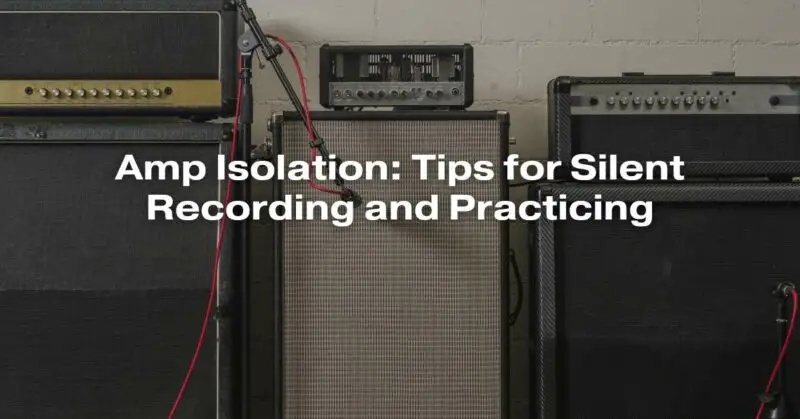Playing an electric guitar through an amplifier can be a thrilling experience, but it’s not always practical or considerate of others. Whether you’re a professional musician looking to record quietly in a home studio or a bedroom guitarist trying not to disturb your neighbors, amp isolation is a crucial technique to master. In this article, we’ll explore what amp isolation is, why it’s essential, and provide tips on how to achieve silent recording and practicing effectively.
What is Amp Isolation?
Amp isolation, also known as amp isolation cabinets or silent recording solutions, refers to techniques and equipment used to contain the sound of a guitar amplifier, allowing you to play at high volumes without disturbing others or without external sounds interfering with your recording.
Amp isolation can be essential for several reasons:
- Noise Control: Guitar amplifiers can be exceptionally loud, even at lower settings. Amp isolation helps you control the volume, making it possible to practice or record quietly.
- Recording: When recording electric guitars, capturing the pure amp sound without room acoustics or external noises is often essential. Amp isolation ensures a clean and isolated signal for recording.
- Tone and Consistency: By isolating the amp, you can maintain the tonal characteristics of your amplifier at any volume, ensuring consistency in your sound.
Now, let’s delve into some tips for achieving effective amp isolation.
1. Use an Isolation Cabinet
An isolation cabinet, or iso cab, is a purpose-built enclosure designed to house a guitar amplifier while containing its sound. These cabinets typically have soundproofing materials and a microphone to capture the amp’s sound. Some popular options include the Rivera Silent Sister, Two Notes Torpedo Captor, and various DIY alternatives.
When using an iso cab:
- Ensure it is adequately sealed to prevent sound leakage.
- Experiment with microphone placement to capture your desired tone.
- Use headphones or studio monitors to monitor your sound.
2. Load Box and Cabinet Simulators
Load boxes are devices that connect between your amplifier’s speaker output and the cabinet. They capture the signal without sending it to a speaker, effectively “loading” the amp. Load boxes like the Universal Audio OX Box and Two Notes Torpedo Live provide cabinet simulation and speaker modeling options, allowing you to send the amp’s signal directly to a mixer, audio interface, or headphones.
Benefits of load boxes and cabinet simulators:
- Excellent for silent recording and direct recording into a DAW.
- Simulate various speaker cabinets and microphones for tonal versatility.
- Reduce wear and tear on your amplifier by not using an actual speaker.
3. Use Amp Modelers and Profilers
Amp modelers and profilers like the Kemper Profiling Amp, Line 6 Helix, and Fractal Audio Axe-Fx can replicate the sound of various amplifiers and cabinets digitally. These devices are highly versatile and offer a wide range of tones, making them suitable for both recording and practicing.
Advantages of amp modelers and profilers:
- Extremely portable and versatile.
- Easily switch between different amp and cabinet simulations.
- Ideal for silent recording, live performances, and practicing with headphones.
4. Employ Attenuators
An attenuator is a device inserted between your amplifier’s output and speaker that absorbs some of the amplifier’s power, allowing you to achieve cranked amp tones at lower volumes. While attenuators don’t provide complete isolation, they can significantly reduce the overall volume of your amp.
Tips for using attenuators:
- Ensure compatibility with your amplifier’s impedance and wattage.
- Adjust the attenuation level to find your preferred balance between volume and tone.
- Monitor the overall volume to avoid excessive sound leakage.
5. Play Through Modeling Amplifiers
Modeling amplifiers like the Boss Katana, Line 6 Spider V, and Fender Mustang GT combine amp modeling technology with built-in speakers. These amps allow you to play silently using headphones and offer a wide array of amp simulations and effects.
Advantages of modeling amplifiers:
- All-in-one solution for practice and recording.
- Lightweight and portable for easy transportation.
- Varied amp and effect options without the need for additional equipment.
6. Soundproof Your Space
If you’re practicing at home and need to contain the sound further, consider soundproofing your practice space. This involves adding acoustic treatment to walls, floors, and ceilings to reduce sound transmission. Acoustic foam panels, bass traps, and isolation platforms can help create a quieter environment.
Key tips for soundproofing:
- Seal gaps and cracks in doors and windows.
- Use heavy curtains or acoustic blankets to cover windows.
- Consider a dedicated practice room with extra soundproofing measures.
Conclusion
Amp isolation is a crucial technique for guitarists who want to practice or record without disturbing others or external noises interfering with their sound. By using isolation cabinets, load boxes, amp modelers, attenuators, or modeling amplifiers, you can achieve silent recording and practicing effectively while preserving the integrity of your amp’s tone.
Remember that the choice of amp isolation method depends on your specific needs, budget, and available space. Experiment with different solutions to find what works best for you, and enjoy the freedom to play your electric guitar at any volume without worries or disruptions.


